国际经济学课后答案版
- 格式:docx
- 大小:433.35 KB
- 文档页数:36
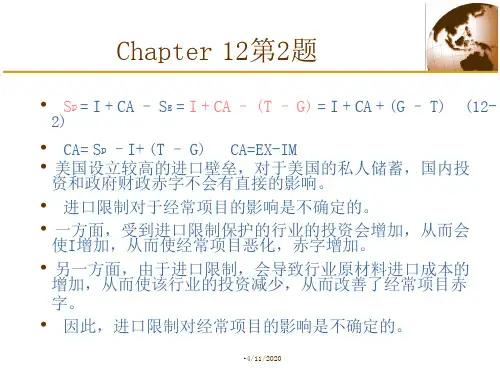
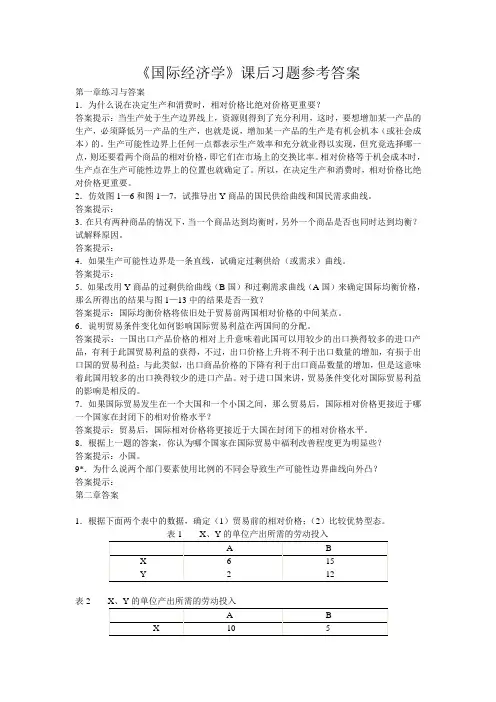
《国际经济学》课后习题参考答案第一章练习与答案1.为什么说在决定生产和消费时,相对价格比绝对价格更重要?答案提示:当生产处于生产边界线上,资源则得到了充分利用,这时,要想增加某一产品的生产,必须降低另一产品的生产,也就是说,增加某一产品的生产是有机会机本(或社会成本)的。
生产可能性边界上任何一点都表示生产效率和充分就业得以实现,但究竟选择哪一点,则还要看两个商品的相对价格,即它们在市场上的交换比率。
相对价格等于机会成本时,生产点在生产可能性边界上的位置也就确定了。
所以,在决定生产和消费时,相对价格比绝对价格更重要。
2.仿效图1—6和图1—7,试推导出Y商品的国民供给曲线和国民需求曲线。
答案提示:3.在只有两种商品的情况下,当一个商品达到均衡时,另外一个商品是否也同时达到均衡?试解释原因。
答案提示:4.如果生产可能性边界是一条直线,试确定过剩供给(或需求)曲线。
答案提示:5.如果改用Y商品的过剩供给曲线(B国)和过剩需求曲线(A国)来确定国际均衡价格,那么所得出的结果与图1—13中的结果是否一致?答案提示:国际均衡价格将依旧处于贸易前两国相对价格的中间某点。
6.说明贸易条件变化如何影响国际贸易利益在两国间的分配。
答案提示:一国出口产品价格的相对上升意味着此国可以用较少的出口换得较多的进口产品,有利于此国贸易利益的获得,不过,出口价格上升将不利于出口数量的增加,有损于出口国的贸易利益;与此类似,出口商品价格的下降有利于出口商品数量的增加,但是这意味着此国用较多的出口换得较少的进口产品。
对于进口国来讲,贸易条件变化对国际贸易利益的影响是相反的。
7.如果国际贸易发生在一个大国和一个小国之间,那么贸易后,国际相对价格更接近于哪一个国家在封闭下的相对价格水平?答案提示:贸易后,国际相对价格将更接近于大国在封闭下的相对价格水平。
8.根据上一题的答案,你认为哪个国家在国际贸易中福利改善程度更为明显些?答案提示:小国。
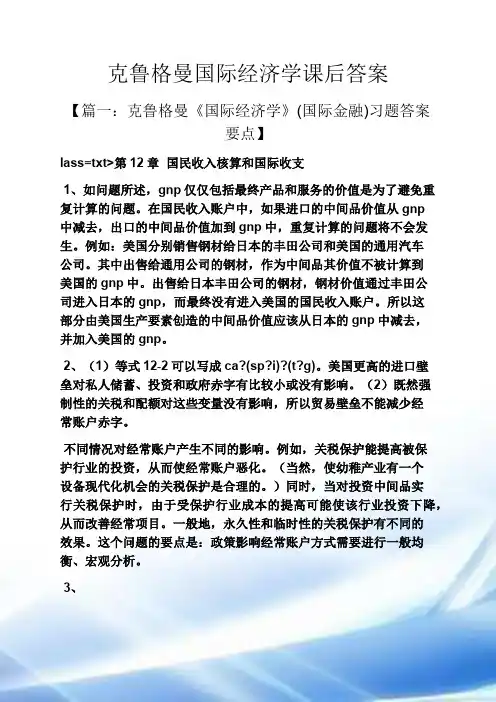
克鲁格曼国际经济学课后答案【篇一:克鲁格曼《国际经济学》(国际金融)习题答案要点】lass=txt>第12章国民收入核算和国际收支1、如问题所述,gnp仅仅包括最终产品和服务的价值是为了避免重复计算的问题。
在国民收入账户中,如果进口的中间品价值从gnp中减去,出口的中间品价值加到gnp中,重复计算的问题将不会发生。
例如:美国分别销售钢材给日本的丰田公司和美国的通用汽车公司。
其中出售给通用公司的钢材,作为中间品其价值不被计算到美国的gnp中。
出售给日本丰田公司的钢材,钢材价值通过丰田公司进入日本的gnp,而最终没有进入美国的国民收入账户。
所以这部分由美国生产要素创造的中间品价值应该从日本的gnp中减去,并加入美国的gnp。
2、(1)等式12-2可以写成ca?(sp?i)?(t?g)。
美国更高的进口壁垒对私人储蓄、投资和政府赤字有比较小或没有影响。
(2)既然强制性的关税和配额对这些变量没有影响,所以贸易壁垒不能减少经常账户赤字。
不同情况对经常账户产生不同的影响。
例如,关税保护能提高被保护行业的投资,从而使经常账户恶化。
(当然,使幼稚产业有一个设备现代化机会的关税保护是合理的。
)同时,当对投资中间品实行关税保护时,由于受保护行业成本的提高可能使该行业投资下降,从而改善经常项目。
一般地,永久性和临时性的关税保护有不同的效果。
这个问题的要点是:政策影响经常账户方式需要进行一般均衡、宏观分析。
3、(1)、购买德国股票反映在美国金融项目的借方。
相应地,当美国人通过他的瑞士银行账户用支票支付时,因为他对瑞士请求权减少,故记入美国金融项目的贷方。
这是美国用一个外国资产交易另外一种外国资产的案例。
(2)、同样,购买德国股票反映在美国金融项目的借方。
当德国销售商将美国支票存入德国银行并且银行将这笔资金贷给德国进口商(此时,记入美国经常项目的贷方)或贷给个人或公司购买美国资产(此时,记入美国金融项目的贷方)。
最后,银行采取的各项行为将导致记入美国国际收支表的贷方。
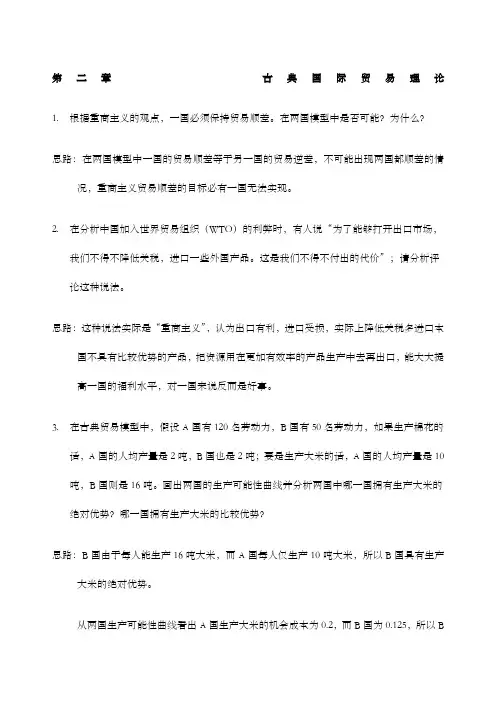
第二章古典国际贸易理论1.根据重商主义的观点,一国必须保持贸易顺差。
在两国模型中是否可能?为什么?思路:在两国模型中一国的贸易顺差等于另一国的贸易逆差,不可能出现两国都顺差的情况,重商主义贸易顺差的目标必有一国无法实现。
2.在分析中国加入世界贸易组织(WTO)的利弊时,有人说“为了能够打开出口市场,我们不得不降低关税,进口一些外国产品。
这是我们不得不付出的代价”;请分析评论这种说法。
思路:这种说法实际是“重商主义”,认为出口有利,进口受损,实际上降低关税多进口本国不具有比较优势的产品,把资源用在更加有效率的产品生产中去再出口,能大大提高一国的福利水平,对一国来说反而是好事。
3.在古典贸易模型中,假设A国有120名劳动力,B国有50名劳动力,如果生产棉花的话,A国的人均产量是2吨,B国也是2吨;要是生产大米的话,A国的人均产量是10吨,B国则是16吨。
画出两国的生产可能性曲线并分析两国中哪一国拥有生产大米的绝对优势?哪一国拥有生产大米的比较优势?思路:B国由于每人能生产16吨大米,而A国每人仅生产10吨大米,所以B国具有生产大米的绝对优势。
从两国生产可能性曲线看出A国生产大米的机会成本为0.2,而B国为0.125,所以B国生产大米的机会成本或相对成本低于A 国,B 国生产大米具有比较优势。
4.理论,决不是个强权理论,只要按照比较优势进行贸易,专业化生产,充分有效地利用资源,穷国也可以得到好处,这不仅可以从Sachs 和Warner 对78个发展中国家贸易与经济发展的关系研究中的得到证实,单从中国改革开放的实践就可以得到说明。
5. 下表列出了加拿大和中国生产1单位计算机和1单位小麦所需的劳动时间。
假定生产计算机和小麦都只用劳动,加拿大的总劳动为600小时,中国总劳动为800小时。
(1) 计算不发生贸易时各国生产计算机的机会成本。
(2) 哪个国家具有生产计算机的比较优势?哪个国家具有生产小麦的比较优势?800 1200(3)如果给定世界价格是1单位计算机交换22单位的小麦,加拿大参与贸易可以从每单位的进口中节省多少劳动时间?中国可以从每单位进口中节省多少劳动时间?如果给定世界价格是1单位计算机交换24单位的小麦,加拿大和中国分别可以从进口每单位的货物中节省多少劳动时间?(4)在自由贸易的情况下,各国应生产什么产品,数量是多少?整个世界的福利水平是提高还是降低了?试用图分析。
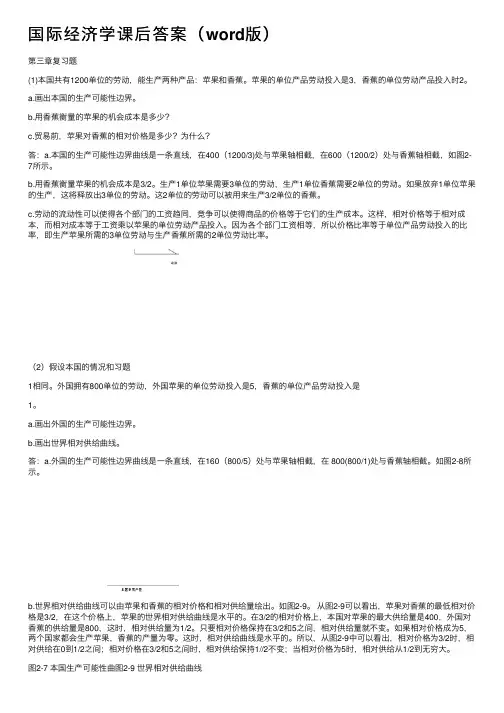
国际经济学课后答案(word版)第三章复习题(1)本国共有1200单位的劳动,能⽣产两种产品:苹果和⾹蕉。
苹果的单位产品劳动投⼊是3,⾹蕉的单位劳动产品投⼊时2。
a.画出本国的⽣产可能性边界。
b.⽤⾹蕉衡量的苹果的机会成本是多少?c.贸易前,苹果对⾹蕉的相对价格是多少?为什么?答:a.本国的⽣产可能性边界曲线是⼀条直线,在400(1200/3)处与苹果轴相截,在600(1200/2)处与⾹蕉轴相截,如图2-7所⽰。
b.⽤⾹蕉衡量苹果的机会成本是3/2。
⽣产1单位苹果需要3单位的劳动,⽣产1单位⾹蕉需要2单位的劳动。
如果放弃1单位苹果的⽣产,这将释放出3单位的劳动。
这2单位的劳动可以被⽤来⽣产3/2单位的⾹蕉。
c.劳动的流动性可以使得各个部门的⼯资趋同,竞争可以使得商品的价格等于它们的⽣产成本。
这样,相对价格等于相对成本,⽽相对成本等于⼯资乘以苹果的单位劳动产品投⼊。
因为各个部门⼯资相等,所以价格⽐率等于单位产品劳动投⼊的⽐率,即⽣产苹果所需的3单位劳动与⽣产⾹蕉所需的2单位劳动⽐率。
(2)假设本国的情况和习题1相同。
外国拥有800单位的劳动,外国苹果的单位劳动投⼊是5,⾹蕉的单位产品劳动投⼊是1。
a.画出外国的⽣产可能性边界。
b.画出世界相对供给曲线。
答:a.外国的⽣产可能性边界曲线是⼀条直线,在160(800/5)处与苹果轴相截,在 800(800/1)处与⾹蕉轴相截。
如图2-8所⽰。
b.世界相对供给曲线可以由苹果和⾹蕉的相对价格和相对供给量绘出。
如图2-9。
从图2-9可以看出,苹果对⾹蕉的最低相对价格是3/2,在这个价格上,苹果的世界相对供给曲线是⽔平的。
在3/2的相对价格上,本国对苹果的最⼤供给量是400,外国对⾹蕉的供给量是800,这时,相对供给量为1/2。
只要相对价格保持在3/2和5之间,相对供给量就不变。
如果相对价格成为5,两个国家都会⽣产苹果,⾹蕉的产量为零。
这时,相对供给曲线是⽔平的。
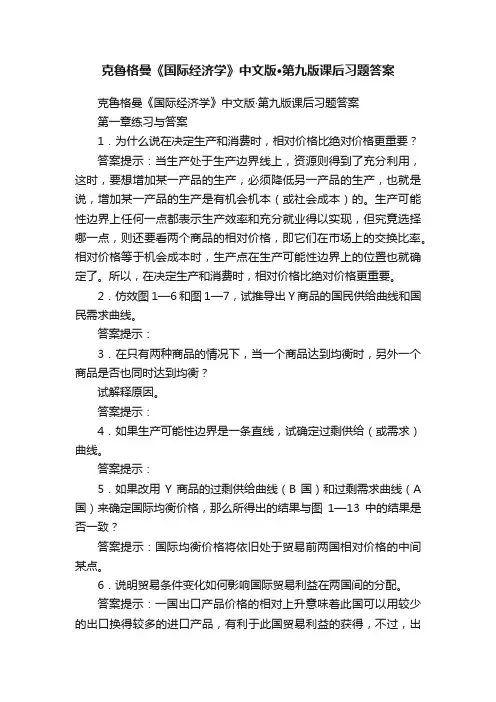
克鲁格曼《国际经济学》中文版·第九版课后习题答案克鲁格曼《国际经济学》中文版·第九版课后习题答案第一章练习与答案1.为什么说在决定生产和消费时,相对价格比绝对价格更重要?答案提示:当生产处于生产边界线上,资源则得到了充分利用,这时,要想增加某一产品的生产,必须降低另一产品的生产,也就是说,增加某一产品的生产是有机会机本(或社会成本)的。
生产可能性边界上任何一点都表示生产效率和充分就业得以实现,但究竟选择哪一点,则还要看两个商品的相对价格,即它们在市场上的交换比率。
相对价格等于机会成本时,生产点在生产可能性边界上的位置也就确定了。
所以,在决定生产和消费时,相对价格比绝对价格更重要。
2.仿效图1—6和图1—7,试推导出Y商品的国民供给曲线和国民需求曲线。
答案提示:3.在只有两种商品的情况下,当一个商品达到均衡时,另外一个商品是否也同时达到均衡?试解释原因。
答案提示:4.如果生产可能性边界是一条直线,试确定过剩供给(或需求)曲线。
答案提示:5.如果改用Y商品的过剩供给曲线(B国)和过剩需求曲线(A 国)来确定国际均衡价格,那么所得出的结果与图1—13中的结果是否一致?答案提示:国际均衡价格将依旧处于贸易前两国相对价格的中间某点。
6.说明贸易条件变化如何影响国际贸易利益在两国间的分配。
答案提示:一国出口产品价格的相对上升意味着此国可以用较少的出口换得较多的进口产品,有利于此国贸易利益的获得,不过,出口价格上升将不利于出口数量的增加,有损于出口国的贸易利益;与此类似,出口商品价格的下降有利于出口商品数量的增加,但是这意味着此国用较多的出口换得较少的进口产品。
对于进口国来讲,贸易条件变化对国际贸易利益的影响是相反的。
7.如果国际贸易发生在一个大国和一个小国之间,那么贸易后,国际相对价格更接近于哪一个国家在封闭下的相对价格水平?答案提示:贸易后,国际相对价格将更接近于大国在封闭下的相对价格水平。
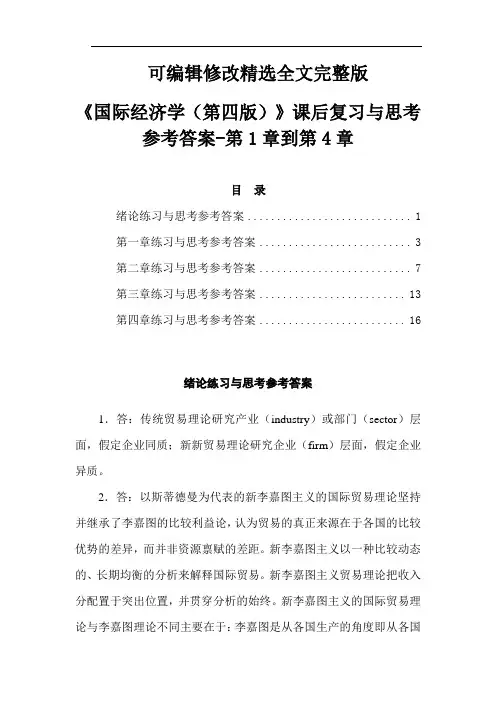
可编辑修改精选全文完整版《国际经济学(第四版)》课后复习与思考参考答案-第1章到第4章目录绪论练习与思考参考答案 (1)第一章练习与思考参考答案 (3)第二章练习与思考参考答案 (7)第三章练习与思考参考答案 (13)第四章练习与思考参考答案 (16)绪论练习与思考参考答案1.答:传统贸易理论研究产业(industry)或部门(sector)层面,假定企业同质;新新贸易理论研究企业(firm)层面,假定企业异质。
2.答:以斯蒂德曼为代表的新李嘉图主义的国际贸易理论坚持并继承了李嘉图的比较利益论,认为贸易的真正来源在于各国的比较优势的差异,而并非资源禀赋的差距。
新李嘉图主义以一种比较动态的、长期均衡的分析来解释国际贸易。
新李嘉图主义贸易理论把收入分配置于突出位置,并贯穿分析的始终。
新李嘉图主义的国际贸易理论与李嘉图理论不同主要在于:李嘉图是从各国生产的角度即从各国的生产特点不同和劳动效率的高低不同上来解释比较优势的差异;新李嘉图主义不仅从各国生产的角度来分析和比较各国的比较优势的差异,而且强调要从各国分配领域,从经济增长、经济发展的动态角度来分析和比较各国比较优势的不同。
3.答:北京师范大学李翀教授认为,马克思曾经有一个六册著作的写作计划,准备研究国内和国际经济问题,建立一个完整的经济理论体系。
然而遗憾的是,马克思没有能够完成他的研究工作。
将马克思经济学的基本理论和基本方法应用于国际经济问题的研究,构建马克思主义国际经济学理论体系,是一个很有意义的研究领城。
随着经济的全球化,国际经济体系已经成熟,建立马克思主义国际经济学的条件已经具备。
国际经济的本质是资本的跨国流动,因此,应该从商品资本、生产资本、货币资本的跨国流动三个方面来构建马克思主义国际经济学。
在商品资本的跨国流动方面,需要从国际价值、生产价格和垄断价格等基本范畴出发,来分析国际贸易的原因、流向和利益分配。
在生产资本的跨国流动方面,需要从生产资本本质的角度重新构建直接投资的原因、流向和利益分配。
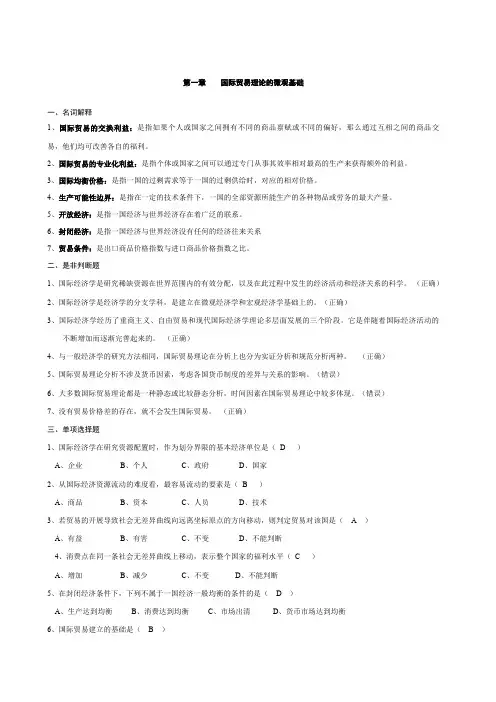
第一章国际贸易理论的微观基础一、名词解释1、国际贸易的交换利益:是指如果个人或国家之间拥有不同的商品禀赋或不同的偏好,那么通过互相之间的商品交易,他们均可改善各自的福利。
2、国际贸易的专业化利益:是指个体或国家之间可以通过专门从事其效率相对最高的生产来获得额外的利益。
3、国际均衡价格:是指一国的过剩需求等于一国的过剩供给时,对应的相对价格。
4、生产可能性边界:是指在一定的技术条件下,一国的全部资源所能生产的各种物品或劳务的最大产量。
5、开放经济:是指一国经济与世界经济存在着广泛的联系。
6、封闭经济:是指一国经济与世界经济没有任何的经济往来关系7、贸易条件:是出口商品价格指数与进口商品价格指数之比。
二、是非判断题1、国际经济学是研究稀缺资源在世界范围内的有效分配,以及在此过程中发生的经济活动和经济关系的科学。
(正确)2、国际经济学是经济学的分支学科,是建立在微观经济学和宏观经济学基础上的。
(正确)3、国际经济学经历了重商主义、自由贸易和现代国际经济学理论多层面发展的三个阶段。
它是伴随着国际经济活动的不断增加而逐渐完善起来的。
(正确)4、与一般经济学的研究方法相同,国际贸易理论在分析上也分为实证分析和规范分析两种。
(正确)5、国际贸易理论分析不涉及货币因素,考虑各国货币制度的差异与关系的影响。
(错误)6、大多数国际贸易理论都是一种静态或比较静态分析,时间因素在国际贸易理论中较多体现。
(错误)7、没有贸易价格差的存在,就不会发生国际贸易。
(正确)三、单项选择题1、国际经济学在研究资源配置时,作为划分界限的基本经济单位是(D )A、企业B、个人C、政府D、国家2、从国际经济资源流动的难度看,最容易流动的要素是(B )A、商品B、资本C、人员D、技术3、若贸易的开展导致社会无差异曲线向远离坐标原点的方向移动,则判定贸易对该国是( A )A、有益B、有害C、不变D、不能判断4、消费点在同一条社会无差异曲线上移动,表示整个国家的福利水平(C )A、增加B、减少C、不变D、不能判断5、在封闭经济条件下,下列不属于一国经济一般均衡的条件的是( D )A、生产达到均衡B、消费达到均衡C、市场出清D、货币市场达到均衡6、国际贸易建立的基础是( B )A、绝对价格B、相对价格C、不变价格D、以上三种都不是7、在封闭经济条件下,A国X商品的相对价格低于B国X商品的相对价格,我们称A国在X商品上具有( B )A、绝对优势B、比较优势C、没有优势D、以上三种都不是8、一国从国际贸易中所获利益的多寡取决于( D )A、市场占有率B、技术优势C、竞争优势D、贸易条件四、简述题:1、试用图形分析国际贸易的交换利益和专业化利益。

international(国际经济学)课后习题及答案----------------------- Page 1-----------------------Review Questions and Condensed Answers forInternational Trade TheoriesChapter 1 World Trade and the National EconomyReview Questions::::1( What features distinguish international from domestic transactions?2( What can you say about the growth of world trade in both nominal and real terms? Was itfaster than the growth of output?3( Evaluate the statement,” the United States is a closed economy, hence foreign trade is ofno consequence to it.”4( Distinguish between export industries, import-competing industries and nontraded goods.Give examples of each.5( Using the figure in table 1-3, what can you say about the trade structure of the USA andJapan.Condensed Answers to Review Questions::::1. The text discusses ways that international transactions differfrom domestic ones.i. International trade requires that transactions be conductedbetween twocurrencies mediated by an exchange rate. Domestic transactions are conductedin a single currency.ii. Commercial policies that operate to restrict international transactions cannot, ingeneral, be imposed on domestic trade. Such policies include tariffs, quotas,voluntary export restraints, export subsidies, and exchange controls.iii. Countries pursue different domestic macroeconomic policieswhich result indivergent rates of economic growth, inflation, and unemployment.iv. More statistical data exist on the nature, volume, and value of internationaltransactions than exist in domestic trade.v. Factors of production are more mobile domestically than internationally.vi. Countries exhibit different demand patterns, sales techniques,and marketingrequirements. Many of these are due to culture and custom. Someresult fromdifferences in government regulations. Included here are health, safety,environmental, and technical rules.2. The real volume of world exports grew at an annual rate of more than 6 percent between1950 and 2000. Global output grew at an annual rate of 4 percent. Export growth inexcess of output growth reflects the increased openness to trade of many countries.3. The United States is a relatively closed economy since the share of trade in GDP issmaller than that of most other industrial nations. In 2000, U.S. exports of goods andservices were 11 percent of GDP. The U.S. economy is less dependent on the foreignsector than other major economies, but to say that foreign trade is of no consequence is anexaggeration. The U.S. economy has become increasingly open and, therefore, moreimpacted by trade developments over time. This trend is likely to continue. Curtailingimports would, for example, have a big effect on consumers' ability to buy some goods----------------------- Page 2-----------------------(e.g. tropical products) and would raise the prices of others. The absence of certain keycommodities and material inputs would greatly disrupt areas of U.S. industry.4. a. Export industries send a substantial share of their output abroad. Ratios ofexports to GDP are much higher than the average ratio for all industries. Netexporting industries are those for which exports exceed imports. U.S. netexporting industries include farm products, chemicals, certain types of machinery,and aerospace products.b. Import-competing industries are domestic industries that sharethe domesticmarket with a substantial import presence. These activities haveratios ofimports to GDP that are much higher than the average ratio for all industries.U.S. import-competing industries include fuels, automobiles,clothing, footwear,and iron and steel.c. Nontraded goods are those which, because of their nature and characteristics, arenot easily exported or imported. Examples are hair-dressing, movie theaters,meals, construction activity, and health-care.5. Table 1.3 contains figures on the trade structure of the U.S. and Japan. The U.S. is a netexporter of food, certain ores, chemicals, and other machinery and transport equipment,and is a net importer of raw materials, mining products, fuels, nonferrous metals, iron andsteel, semimanufactures, office and telecommunications equipment, automotive products,textiles and clothing, and other consumer goods. Japan is a net exporter of iron and steel,chemicals, semimanufactures, office and telecommunications equipment, automotiveproducts, other machinery and transport equipment, and other consumer goods. Importsexceed exports in food, raw materials, and textiles and clothing.----------------------- Page 3-----------------------Chapter 2 Why Nations TradeReview Questions::::1( a. In what sense are the cost data of footnote 4 related to the figures of scheme 1?b. Based on the figures of footnote 4, determine the:Direction of trade once it develops.Limits to mutually beneficial trade.Limits to a sustainable exchange trade.2. Evaluate the following statements:a. In international trade, domestic cost ratios determine the limits of mutually beneficial trade,whereas demand considerations show where, within these limits, the actual exchange ratio will lie.b. Comparative advantage is a theoretical concept. It cannot be used to explain any real-worldphenomena.c. The opening up of trade raises the price of export goods; hence trade is inflationary.d. The concept of absolute advantage offers explainations for East Germany’s high unemploymentrates in the 1990s.3. a. Use the theory of comparative advantage to explain why it pays for:The USA to export grains and import oil.Russia to export oil and import grains.b. Why does the popular press believe that grain exports are inflnationary? What is wrongwith this porposition?Condensed Answers to Review Questions:1. a. Scheme 1 is based on labor productivity comparisons, while Footnote 4presentsper unit cost data. Production cost ratios are inversely related to productivitymeasures.b. i. Textiles will be exported from the U.K. and wheat from the U.S.ii. The U.S. will trade only if one yard of textiles costs less than3 bushels ofwheat. The U.K. will trade only if 1 yard of textiles can be exchangedfor more than 2 bushels of wheat.iii. The value of the ? must be between $1 and $1.502. a. Consider Figure 2.2. The domestic cost ratios define limits of mutually beneficialtrade. Within the region of mutually beneficial trade the actual exchange rate willbe determined by the relative intensity of each country's demand for the othercountry's product. A full analysis requires an understanding of reciprocal demandcurves, but the following general principle might help heuristically. If the Britishare more eager to buy U.S. wheat than the Americans are eager for British textiles,the exchange ratio falls close to the U.K. domestic cost ratio and the U.S. can beviewed as capturing a greater share of the gains from trade.b. Since the real world does not conform to the convenienttwo-country, two-goodassumptions, the simple theoretical model is not immediately applicable.However, we can generalize the model to many goods and many nations. Thefundamental truth remains. Countries export those goods in which their relativeproduction costs are lower and import those goods for which the relative costs arehigher.----------------------- Page 4-----------------------c. While trade tends to raise the prices of exportables in the domestic economy, theeffect of trade is to lower the average price level of all goods. Trade givesconsumers an opportunity to consume at lower world prices. Many goods will becheaper when purchased from foreign supply sources. Trade also conveysprocompetitive effects, stimulates the adoption of new technologies, and allowsfirms to achieve efficient scale production levels. Thus, trade is anti-inflationary.d. The reunification of the Germany economy in 1990 was undertaken on the basisthat a unit of the deutschmark, the West German currency, should be equal in valueto a unit of the ostmark, the East German currency. At this exchange rate, goodsproduced in East Germany were almost universally more expensive to producethan their counterparts in the West. Labor productivity in East Germanmanufacturing was found to be about 35% of the West German level. Underthese conditions the East German manufacturing sector collapsed. Investors werereluctant to purchase East German factories and large scale closures and dismissalsresulted.3. a. The U.S. enjoys a comparative advantage in grains. It also produces oil, but will gain byspecializing in grain production and using proceeds of exported agriculturalproducts to purchase oil from nations that produce oil relatively more efficiently.Russia is relatively more efficient in the production of oil and will gain bypurchasing grain from the U.S. in exchange for oil.b. The popular press asserts that by exporting grain from the U.S. (say to the former U R)we are lowering the domestic supply of grain and raising the domestic U.S. price of grain. Sincegrain is an important ingredient in many food products, grain exports are believed to increase theprice of those products. However, the price of grain is determined in world markets. U.S.exports alone cannot permanently raise the domestic U.S. price. If the domestic U.S. grainpricerose above the world price, the U.S. would be a net importer of grains and the domestic price wouldfall.----------------------- Page 5-----------------------Chapter 3 The Commodity Composition of TradeReview Questions::::1( Does the factor proportions theory provide a good explanation of intraindustry trade? Ifnot, can you outline an alternative explaination for the growing phenomenon?2( Explain the dynamic nature of comparative advantage using Japan’s experience as anexample.3( Once the United States acquires a comparative advantage in jet aircraft production it canbe sure of a dominant position in the global market forever. Do you agree with thisstatement? Explain.Condensed Answers to Review Questions1. The factor proportions theory is better suited to explain interindustry trade, or the exchangebetween countries of totally different commodities, than intraindustry trade, which is thetwo-way trade of similar commodities. The growth of intraindustry trade is greatest inimperfectly competitive industries characterized by economies of scale. Here, scaleeconomies force firms in each industry to specialize in a narrow range of products withineach industry to achieve efficient scale operations. Intraindustry specialization combinedwith diverse consumer tastes gives rise to two-way trade within the same industryclassification.2. Japan's comparative advantage in the immediate post-war period was in labor intensivegoods. The high level of saving and investment transformed Japan into a relatively capitalabundant country. Its advantage in the labor-intensive industries was lost as wages rose.Moreover, Japan increased its technological capability through high spending on R&D.Now Japan's advantage lies in the production of high-tech, capital intensive goods similar tothe U.S. This in large part explains the increasing trade friction between the twocountries.3. Once the U.S. acquires a comparative advantage in jet aircraft, it is likely to enjoy a dominantposition in the global marketplace for years, but not forever. Jet aircraft production is characterizedby huge economies of scale due largely to research and development costs. High capitalrequirements and scale economies pose large entry barriers. It is extremely difficult for a countryto enter into aircraft production once the U.S. has the lead. The new firm would initially have asmall market share and would be unable to compete on a cost basis. The new market entrant wouldrequire considerable government support and encouragement. This was the case with the EuropeanAirbus.----------------------- Page 6-----------------------Chapter 4 Protection of Domestic Industries: The TariffReview Questions::::1( A tariff on textiles is equivalent to a tax on consumers and a subsidy to the textileproducers and workers.2( Explain the concept of effective rate of protection.a. What does the effective rate on final goods depend upon and how?b. In what way does the effective rate analysis help to illuminate these policy issues:Deepening of production in LDCsEscalation of tariff rates by degree of processing in industrial countries3. A tariff lowers the real income of the country, while at the same time it distributes income fromconsumers to the governments and to the import-competing industry.Condensed Answers to Review Questions:1. The effect of a tariff is comparable to the combined effects of a tax on consumers and a subsidy toproducers. Using Figure 4.3, one can show a tariff results in a transfer of resources from theconsumers (who lose P P fd ) to the producers (who gain P P ec). With a non-prohibitive tariff, the2 3 2 3government will also gain revenue efmn. Whether the two schemes are equivalent depends on theexact nature of the tax and subsidy scheme.2. a. The effective rate of protection measures the percentage increase in domesticvalue added per unit of output made possible by tariffs on the output and onmaterial inputs. Determinants of the effective rate include thetariff on the finalproduct, tariffs on the imported material inputs, and the free trade value added perunit of output which is influenced by intermediate input coefficients. Effectiverates are positively related to the tariff on the final product and negatively related toboth tariffs on imported inputs and the free trade value added. A derivation ofthe formula appears in footnote 10, and footnote 12 interprets that formula.b. "Deepening" of production in LDCs involves import substitution industrializationpolicy. A final assembly plant is given a protective tariff and imported inputs areaccorded duty free treatment. As a second stage, the LDC begins to deepenproduction by manufacturing inputs and according them protection. By imposingtariffs on imported inputs, the LDC is reducing effective protection for the finalgood.Because of relatively high rates of protection on finished goods and low protectionon unfinished goods and raw materials, effective tariff rates in developed countriesmay be as much as double their nominal counterparts. Developing countriesmaintain that such tariff structures fatally harm their efforts to increase exports offinished manufactures.3. Again using Figure4.3, the loss in real income is shown by triangles cen and mfd.Redistribution has been given in 8a.----------------------- Page 7-----------------------Chapter 5 Nontariff Barriers (NTBs) to TradeReview Question::::Suppose the USA steel industry is seeking protection from foreign imports. Compare andcontrast the following measures of restricting steel industries: a tariff, a quota, and voluntaryexport restraints.Condensed Answers to Review Question:There are a variety of ways in which a tariff may be considered to be less harmful than an equivalentquota:i. The revenue effect. Tariffs provide revenue. Quotas do not automatically providerevenue. Under a quota, revenue accrues to holders of import licenses.Depending on the quota scheme, licenses may be held by domestic importers, foreign exporters, foreign governments, or domestic officialswho may use them to encourage bribery. Only through auctioning or selling licenses can the government capture quota rents.ii. Performance under demand and supply changes. Any amount of imports can enterunder a tariff, but with a quota import volumes are fixed. When demandgrows, or there is a shortfall in supply, the quota does not permit a quantityadjustment. The domestic price can depart significantly from the worldprice. Under a tariff, the domestic price cannot rise above the worldprice by more than the tariff rate. Thus, a tariff is less harmful than aquota.iii. Impact on Exporters. When a tariff is levied on an imported good it is usually rebatedwhen the good is exported. The same is not true for a quota. Quotas maytherefore be more harmful to export performance.iv. Curbing monopoly power. Quotas curtail monopoly power less than an equivalent tariff.v. Terms of Trade Effects. Quotas provide no incentive for exporting nations to absorb partof the price increase; tariffs do if the exporting nation wishes to retainmarket share.vi. Quality Upgrading. Quotas give an incentive for the exporting country to engage in qualityupgrading. Ad valorem tariffs do not provide an incentive for this behavior but specific duties do.VERs share all of the undesirable effects of quotas. When the exporter does the restricting, there isno opportunity to sell import licenses. Quota rents accrue toforeign exporters orgovernments under a VER. Therefore, VERs are more costly to society than anequivalent quota with licenses sold or a tariff. Quantitative restrictions like VERsare discriminatory. VERs are also hard to monitor. Since shipments from thirdparty countries are unrestricted, transshipment throughnonrestricted countries is amajor problem. One advantage of VERs is they do not invite retaliation sincethey are profitable to foreign exporters and governments.Tariffs, quotas and VERs may be equivalent in terms of effects on the domestic price and thevolumeof imports. This may be shown using diagram 5-1. However, there are important differencesdiscussed in 1a. above.----------------------- Page 8-----------------------Chapter 6 International and Regional Trade Organizations Among Developed CountriesReview Questions::::1. Explain the following terms:Trade creation of a customs union.Trade diversion of a customs union.2.What are the conflicts between the WTO and the environmental movement?Condensed Answers to Review Questions:1. Trade creation refers to the replacement of high cost production in each member by importsfrom another member. This effect is favorable to world welfare. Tradediversion is the diversion of trade from a nonmember to a higher cost member.This is unfavorable because it reduces worldwide resource allocative efficiency(See Figure 4-8).The basic approach to calculating welfare effects associated with customs union formation is toconstruct hypothetical estimates of what member country trade patterns wouldhave been in the absence of integration, comparing these with actual trade flows,and attributing any difference to integration. Effects ofintegration can be isolatedby using trade flow data pertaining to nonmember "normalizer" countries over thesame period to suggest what trade patterns would have been expected for memberswithout integration. Assume, in the absence of integration, both total (internalplus external) and external member imports would have grown at the same rates asthe corresponding imports in the normalizer. The normalizer's external importsrefer to its imports from third countries (i.e. intra-trade is excluded). Thenormalizer's internal imports are imports of normalizer countries from each other(e.g. intra-trade). The preintegration member country total import level ismultiplied by the corresponding normalizer import growth rate to yield an estimateof hypothetical total imports without integration. When compared with actualtotal imports, an estimate of trade creation is obtained. Trade diversion isestimated by multiplying the member country preintegration external import levelby the normalizer's rate of change of external imports to yield hypothetical membercountry external imports. The excess of hypothetical over actual external importsconstitutes trade diversion. The European Union (EU) is a customs unioncomprised of 15 West European countries.2. WTO rules often conflict with both international environmental agreements and nationalenvironmental laws. For example, a 1991 GATT panel upheld a Mexican challenge to aU.S. law banning importation of tuna caught indolphin-killing purse-seine nets.GATT/WTO provisions are concerned with products and not production methods.----------------------- Page 9-----------------------Chapter 7 International Mobility of Productive FactorsReview Question::::What is the meaning of DFI? List some of the factors that induce companies to invest abroad.Condensed Answers to Review Question:Direct Foreign Investment refers to international capital movement that gives a company controlover a foreign subsidiary. It may be the purchase of an existing company, a substantial part of itsshares, or the establishment of a new enterprise. It should be contrasted with portfolio investmentthat gives, by and large, no control over foreign assets.The motives are diverse and any particular investment may involve one or more of the followingi. investment in extractive industries to secure raw material supplies;ii. investment in manufacturing industry to take advantage of cheaper foreign labor;iii. to locate production close to foreign markets and avoid transportation costs;iv. to take advantage of incentives offered by host countries;v. to circumvent tariff barriers;vi. changes in the exchange values of currencies; andvii. marketing considerations.。
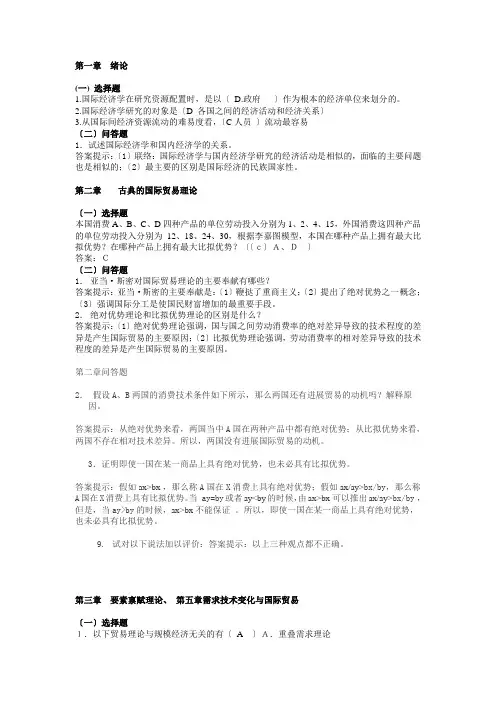
第一章绪论(一) 选择题1.国际经济学在研究资源配置时,是以〔D.政府〕作为根本的经济单位来划分的。
2.国际经济学研究的对象是〔D 各国之间的经济活动和经济关系〕3.从国际间经济资源流动的难易度看,〔C人员〕流动最容易〔二〕问答题1.试述国际经济学和国内经济学的关系。
答案提示:〔1〕联络:国际经济学与国内经济学研究的经济活动是相似的,面临的主要问题也是相似的;〔2〕最主要的区别是国际经济的民族国家性。
第二章古典的国际贸易理论〔一〕选择题本国消费A、B、C、D四种产品的单位劳动投入分别为1、2、4、15,外国消费这四种产品的单位劳动投入分别为12、18、24、30,根据李嘉图模型,本国在哪种产品上拥有最大比拟优势?在哪种产品上拥有最大比拟优势?〔〔c〕A、D〕答案:C〔二〕问答题1.亚当·斯密对国际贸易理论的主要奉献有哪些?答案提示:亚当·斯密的主要奉献是:〔1〕鞭挞了重商主义;〔2〕提出了绝对优势之一概念;〔3〕强调国际分工是使国民财富增加的最重要手段。
2.绝对优势理论和比拟优势理论的区别是什么?答案提示:〔1〕绝对优势理论强调,国与国之间劳动消费率的绝对差异导致的技术程度的差异是产生国际贸易的主要原因;〔2〕比拟优势理论强调,劳动消费率的相对差异导致的技术程度的差异是产生国际贸易的主要原因。
第二章问答题2.假设A、B两国的消费技术条件如下所示,那么两国还有进展贸易的动机吗?解释原因。
答案提示:从绝对优势来看,两国当中A国在两种产品中都有绝对优势;从比拟优势来看,两国不存在相对技术差异。
所以,两国没有进展国际贸易的动机。
3.证明即使一国在某一商品上具有绝对优势,也未必具有比拟优势。
答案提示:假如ax>bx,那么称A国在X消费上具有绝对优势;假如ax/ay>bx/by,那么称A国在X消费上具有比拟优势。
当 ay=by或者ay<by的时候,由ax>bx可以推出ax/ay>bx/by,但是,当ay>by的时候,ax>bx不能保证。
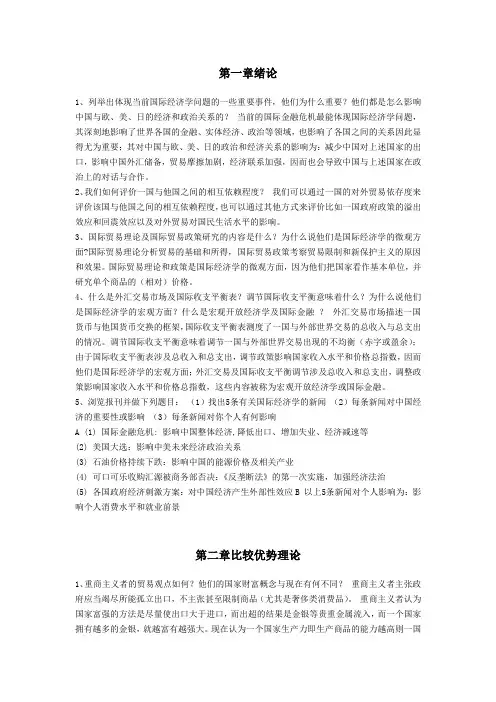
第一章绪论1、列举出体现当前国际经济学问题的一些重要事件,他们为什么重要?他们都是怎么影响中国与欧、美、日的经济和政治关系的?当前的国际金融危机最能体现国际经济学问题,其深刻地影响了世界各国的金融、实体经济、政治等领域,也影响了各国之间的关系因此显得尤为重要;其对中国与欧、美、日的政治和经济关系的影响为:减少中国对上述国家的出口,影响中国外汇储备,贸易摩擦加剧,经济联系加强,因而也会导致中国与上述国家在政治上的对话与合作。
2、我们如何评价一国与他国之间的相互依赖程度?我们可以通过一国的对外贸易依存度来评价该国与他国之间的相互依赖程度,也可以通过其他方式来评价比如一国政府政策的溢出效应和回震效应以及对外贸易对国民生活水平的影响。
3、国际贸易理论及国际贸易政策研究的内容是什么?为什么说他们是国际经济学的微观方面?国际贸易理论分析贸易的基础和所得,国际贸易政策考察贸易限制和新保护主义的原因和效果。
国际贸易理论和政策是国际经济学的微观方面,因为他们把国家看作基本单位,并研究单个商品的(相对)价格。
4、什么是外汇交易市场及国际收支平衡表?调节国际收支平衡意味着什么?为什么说他们是国际经济学的宏观方面?什么是宏观开放经济学及国际金融?外汇交易市场描述一国货币与他国货币交换的框架,国际收支平衡表测度了一国与外部世界交易的总收入与总支出的情况。
调节国际收支平衡意味着调节一国与外部世界交易出现的不均衡(赤字或盈余);由于国际收支平衡表涉及总收入和总支出,调节政策影响国家收入水平和价格总指数,因而他们是国际经济学的宏观方面;外汇交易及国际收支平衡调节涉及总收入和总支出,调整政策影响国家收入水平和价格总指数,这些内容被称为宏观开放经济学或国际金融。
5、浏览报刊并做下列题目:(1)找出5条有关国际经济学的新闻(2)每条新闻对中国经济的重要性或影响(3)每条新闻对你个人有何影响A (1) 国际金融危机: 影响中国整体经济,降低出口、增加失业、经济减速等(2) 美国大选:影响中美未来经济政治关系(3) 石油价格持续下跌:影响中国的能源价格及相关产业(4) 可口可乐收购汇源被商务部否决:《反垄断法》的第一次实施,加强经济法治(5) 各国政府经济刺激方案:对中国经济产生外部性效应B 以上5条新闻对个人影响为:影响个人消费水平和就业前景第二章比较优势理论1、重商主义者的贸易观点如何?他们的国家财富概念与现在有何不同?重商主义者主张政府应当竭尽所能孤立出口,不主张甚至限制商品(尤其是奢侈类消费品)。
第一章1.为什么说在决定生产和消费时,相对价格比绝对价格更重要答案提示:当生产处于生产边界线上,资源则得到了充分利用,这时,要想增加某一产品的生产,必须降低另一产品的生产,也就是说,增加某一产品的生产是有机会机本或社会成本的;生产可能性边界上任何一点都表示生产效率和充分就业得以实现,但究竟选择哪一点,则还要看两个商品的相对价格,即它们在市场上的交换比率;相对价格等于机会成本时,生产点在生产可能性边界上的位置也就确定了;所以,在决定生产和消费时,相对价格比绝对价格更重要2.仿效图1—6和图1—7,试推导出Y商品的国民供给曲线和国民需求曲线;答:参见教材第一章第二节内容,将图1-6a中,以横坐标表示y商品的供给,以纵坐标表示x商品供给,得出相应生产可能性边界线,然后将图1-6b中,以横坐标表示y商品供给,以纵坐标表示y的相对价格,通过类似推导可得出国民供给曲线,国民需求曲线作类似推导可得;3.在只有两种商品的情况下,当一个商品达到均衡时,另外一个商品是否也同时达到均衡答:两种商品同时达到均衡;一种商品均衡时,由其相对价格,机会成本,需求可知另一种商品得相对价格,机会成本和需求;4.如果生产可能性边界是一条直线,试确定过剩供给或需求曲线;答案提示:略,参见书上5.如果改用Y商品的过剩供给曲线B国和过剩需求曲线A国来确定国际均衡价格,那么所得出的结果与图1—13中的结果是否一致答案提示:国际均衡价格将依旧处于贸易前两国相对价格的中间某点;6.说明贸易条件变化如何影响国际贸易利益在两国间的分配;答案提示:一国出口产品价格的相对上升意味着此国可以用较少的出口换得较多的进口产品,有利于此国贸易利益的获得,不过,出口价格上升将不利于出口数量的增加,有损于出口国的贸易利益;与此类似,出口商品价格的下降有利于出口商品数量的增加,但是这意味着此国用较多的出口换得较少的进口产品;对于进口国来讲,贸易条件变化对国际贸易利益的影响是相反的;7.如果国际贸易发生在一个大国和一个小国之间,那么贸易后,国际相对价格更接近于哪一个国家在封闭下的相对价格水平答案提示:贸易后,国际相对价格将更接近于大国在封闭下的相对价格水平;因为大国是国际价格制定者,小国是价格接受者8.根据上一题的答案,你认为哪个国家在国际贸易中福利改善程度更为明显些答案提示:小国;根据上题结论,知道,小国消费者可以从大国购买相对便宜的外国具有比较优势的产品,以较高相对价格出口本国具有比较优势的产品,从而改善福利;9.为什么说两个部门要素使用比例的不同会导致生产可能性边界曲线向外凸略;因为机会成本递增第二章1.根据下面两个表中的数据,确定1贸易前的相对价格;2比较优势型态;1根据表1知道,A、B两国X、Y劳动生产率,可知X相对价格A国低于B国,A国具有比较优势,B国在Y有比较优势2A国在Y具有比较优势,B国在X具有比较优势2.假设A、B两国的生产技术条件如下所示,那么两国还有进行贸易的动机吗解释原因;答案提示:从绝对优势来看,两国当中A国在两种产品中都有绝对优势;从比较优势来看,两国不存在相对技术差异;所以,两国没有进行国际贸易的动机;3.证明如果一国在某一商品上具有绝对优势,那么也必具有比较优势;——题出错了证明即使一国在某一商品上具有绝对优势,也未必具有比较优势;答:如果ax>bx,则称A国在X生产上具有绝对优势;如果ax/ay>bx/by,则称A国在X生产上具有比较优势;当ay=by或者ay<by的时候,由ax>bx可以推出ax/ay>bx/by,但是,当ay>by的时候,ax>bx不能保证ax/ay>bx/by;所以,即使一国在某一商品上具有绝对优势,也未必具有比较优势;4.根据书中第二个例子的做法,如果按照比较劣势的原则进行国际分工,那么会对世界生产带来什么净影响按照比较劣势分工,世界总福利水平会降低;5.假设某一国家拥有20,000万单位的劳动,X、Y的单位产出所要求的劳动投入分别为5个单位和4个单位,试确定生产可能性边界方程;6.根据上一题的条件,再加上以下几个条件,试确定该国的出口量,并在图中画出贸易三角形;1X的国际相对价格为2;2进口为2,000个单位;答案提示:封闭条件下,此国生产可能性边界的斜率是-1/4/1/5=-5/4=Px/Py;因为X的国际相对价格为2,所以此国出口X进口Y;出口1,000个单位的X可以换得2,000个单位的Y7.在图2—2b中,过剩供给曲线两端是否有界限试解释原因;答案提示:过剩供给曲线两端是有界限的,因为一国生产能力和消费需求是有界限的;8.仿照图2—4,你能否画出这样一种情形:两条曲线的交点所决定的国际均衡价格与某一国封闭下的相对价格完全相同如何解释这种结果答:从大国和小国的角度考虑;大国是国际均衡价格制定者,小国是接受者,因此国际均衡价格与封闭条件下大国相对价格完全相同;9.试对下列说法加以评价:1由于发达国家工资水平高于发展中国家,所以发达国家与发展中国家进行贸易会无利可图;2因为美国的工资水平很高,所以美国产品在世界市场缺乏竞争力;3发展中国家的工资水平比较低是因为国际贸易的缘故;答案提示:以上三种观点都不正确;第三章1.根据下面的两个表,试判断:1哪个国家是资本相对丰富的;2哪个国家是劳动相对丰富的;3如果X是资本密集型产品,Y是劳动密集型产品,那么两国的比较优势如何答案提示:表1中A国劳动相对丰裕,A国在生产Y产品上有比较优势;表2中A国资本相对丰裕,A国在生产X产品上有比较优势;2.如果A国的资本、劳动总量均高于B国,但资本相对更多些,试仿照图3—3和图3—4的做法,确定两国生产可能性边界线的位置关系;答案:参照书上方法作图3.根据上一题,试在图中画出两国在封闭和开放下的一般均衡;答案提示:参考书上做法4.如果两个部门的要素密度完全相同,那么要素禀赋差异还会引发国际贸易吗如果贸易发生的话,那么国际分工与贸易型态如何试将你得出的结果与李嘉图模型加以比较;答案提示:如果两个部门的要素密度完全相同,那么要素禀赋差异将不会引发国际贸易;不过,国际贸易还可能存在,这时候的国际分工将有更多的偶然性质;5.试证明在图3—7中,两国的消费点共同位于从原点出发的一条直线上;答:在消费偏好相似的情况下,相对价格决定消费结构,贸易后相对价格均为国际价格,因此消费结构相同,从而两国的消费点共同位于从原点出发的一条直线上6. 如果两国存在技术差异,那么贸易后两国要素价格是否均等,为什么答案提示:如果两国存在技术差异,那么贸易后两国要素价格将不均等;可采用图3—8的方式来解释7.需求逆转是否会影响要素价格均等为什么答:不会,因为单位价值等产量曲线与需求因素无关8.如何根据罗伯津斯基定理,来解释要素禀赋不同的两个国家生产可能性边界之间的差别答案提示:罗伯津斯基定理是,在商品相对价格不变的前提下,某一要素的增加会导致密集使用该要素部门的生产增加,而另一部门的生产则下降;如果两个国家的要素禀赋不一样,则某种要素多的国家,会生产更多密集使用该要素的产品,反之亦然;所以,两个国家的生产可能性边界就出现了差别;9.如果一国的资本与劳动同时增加,那么在下列情况下,两种产品的生产以及该国的贸易条件如何变化1资本、劳动同比例增加;2资本增加的比例大于劳动增加的比例;3资本增加的比例小于劳动增加的比例;答案提示:1两种产品的产量同比例增加,贸易条件没有变化;2资本密集型产品的生产增加更快,资本密集型产品的价格有下降的压力;3劳动密集型产品的生产增加更快,劳动密集型产品的价格有下降的压力;10.对小国来说,经济增长后福利如何变化答案提示:对于小国来说,经济增长以后,不对国际价格形成影响,其贸易条件不会变化,所以福利将上升;11.在战后几十年间,日本、韩国等东亚的一些国家或地区的国际贸易商品结构发生了,明显变化,主要出口产品由初级产品到劳动密集型产品,再到资本密集型产品,试对此变化加以解释;答案提示:随着国际贸易的开展,日本、韩国等东亚国家发挥了比较优势,促进了生产,提高了福利;随着资本的不断积累,日本、韩国等国家的比较优势由起初的初级产品和劳动密集型产品的生产变成了资本密集型产品的生产,所以贸易结构也就相应地发生了变化;12.试析外资流入对东道国贸易条件和比较优势的影响;答案提示:外资流入可以从一定程度上改变东道国的要素禀赋,比如,使得原来资本相对稀缺的国家变成资本相对丰裕的国家;当要素禀赋改变以后,东道国可以发挥新形成的比较优势进行国际贸易,提高福利水平;如果外资流入的东道国在资本密集型产品的生产上增加特别多,以至于影响到国际价格,这将使得此国此种产品的出口价格有下降的压力,不利于贸易条件的维持和改善;第四章1.如果劳动不是同质的话,那么劳动技能的差别是否会造成特定要素的存在试举例说明;答案提示:会的;在长期内,低技术劳动力可经过技术培训成为高技术劳动力,劳动力则不具备特定性2.如果短期内资本和劳动都不能自由流动,那么国际贸易对要素实际收入会产生什么影响答案提示:不变;因为要素密集度不变3.根据本章所建立的特定要素模型,试析劳动增加对要素实际收入和两个部门的生产会产生什么影响提示:将图4—1中的纵坐标由原点Ox或Oy向外平行移动,然后比较一下新旧均衡点;答案提示:劳动增加并且完全就业,则整个经济的资本-劳动比例下降,劳动力价格将下降;劳动力增加将增加密集使用劳动力产品的产量;资本密集型产品的产量下降;4.如果是某一特定要素增加,那么要素实际收入和两个部门的生产又将如何变化提示:考虑一下劳动需求曲线的变动;答案提示:某一特定要素增加,将导致密集使用该要素产品的产量上升,同时由于另一个部门释放出了一部分共同要素,使得另一个部门的产量下降了;共同生产要素的收入将上升;5.根据你对3和4题的回答,试判断在上述两种情况下,罗伯津斯基定理是否依然有效答案提示:依然有效;6.假设某一国能源部门比如石油部门和制造业部门除劳动是共同的投入要素外,各使用一种不同的特定要素,那么,世界市场上能源价格的上涨对该国制造业部门的生产会产生什么影响答案提示:随着世界市场能源价格上升,一部分劳动力将由制造业部门流到能源部门,能源部门产量增加,制造业部门的产量下降;7.根据特定要素模型,试判断短期内国际贸易能否导致要素价格均等化为什么提示:根据要素禀赋理论,长期条件下,要素禀赋的任何变化都不影响要素实际收入,但在短期内,要素禀氟的变化会影响要素实际收入,根据这一区别,并联系一下两国的要素禀赋的差异,再加以分析;答案提示:根据特定要素模型,短期内,特定要素在两个部门间无法流动;按照本章的分析,虽然都是资本,但是x和y部门的资本回报是不一样的,所以不会导致要素价格均等化;第五章1. 试比较重叠需求理论与要素禀赋理论的异同;答案提示:这两个理论都解释了国际贸易的原因;不过,二者也有很大区别;第一,这两个理论解释国际贸易的出发点并不相同;要素禀赋理论是从供给方面来探讨国际贸易的基础;重叠需求理论从需求角度探讨了国际贸易的起因;第二,要素禀赋理论主要解释发生在发达国家与发展中国家之间的产业间贸易,即工业品与初级产品或资本密集型产品与劳动密集型产品之间的贸易;而重叠需求理论则适合于解释发生在发达国家之间的产业内贸易,即制造业内部的一种水平式贸易;2. 你认为重叠需求理论适合解释发展中国家之间的贸易吗为什么答案提示:适合;因为不同的发展中国家在不同的产品生产上有优势,虽然这些产品有可能都是劳动力密集型的产品;发展中国家虽然从总体上发展水平相近,但是在具体产品上却不一样,发展中国家之间也可能有产业内贸易,并用重叠需求理论来解释;3. 重叠需求理论与第三章中所提到的需求逆转都是讨论需求因素对国际贸易的影响,两者之间有什么区别答案提示:需求逆转主要解释产业间贸易,而重叠需求理论则解释产业内贸易;需求逆转解释要素禀赋理论为什么在有的时候不符合现实情况,强调需求有可能使得贸易方向发生变化;重叠需求理论解释的是产业内贸易发生的原因;4.如果考虑收入分配格局这一因素的话,重叠需求理论的结论会受到影响吗为什么答案提示:会有一定影响,但是基本结论不会变;当一个国家收入分配越是平均的时候,本国有代表性的需求所占份额越大,当所有国家的收入分配都非常平均的时候,重叠需求的份额会减少;但是,一个国家的收入分配不可能会完全平均的,所以重叠需求理论的基本结论不会变;5.试举例说明产品周期理论;答案提示:可以以东亚地区的电子产业发展为例;6.试比较产品周期理论与要素禀赋理论的异同;答案提示:产品周期理论是一个动态理论,产品周期理论从技术变化的角度,探讨了比较优势的动态演变;而要素禀赋理论是静态的;两个理论都强调生产方面的优势,即从供给角度讨论问题;7.如果创新国在丧失比较优势之后,转而研究开发新品种,在这种情况下,是否可发生产业内贸易如果发生产业内贸易,那么贸易应发生在哪些国家之间答案提示:创新国如果研究的是相同产业中的更新品种,则创新国和其他发达国家之间会出现产业内贸易,因为此时其他发达国家生产的是此产业产品的旧品种;8.结合重叠需求理论和产品周期理论,试解释为什么美国始终是世界汽车生产和出口大国答案提示:根据产品周期理论,美国作为创新国,一直保持在汽车新产品方面研发和生产的优势,是其保持生产和出口大国的原因;由于欧洲等发达国家的部分消费者也对汽车新品有需求,这使得美国对汽车新品的研发和生产有了动力,较大市场使得新品的研发和生产有利;第六章1.假设劳动是唯一的生产要素,X部门存在外部规模经济,而Y部门则规模收益不变,试确定在这种情况下生产可能性边界的形状;答案提示:生产可能性边界将向内凹;因为出现机会成本递减2.试根据图6—2证明,如果贸易后Y商品的相对价格下降很大的话,那么完全专业化生产Y产品的国家福利可能因贸易而遭受损失;答案提示:比较贸易后的国际相对价格线与贸易前的相对价格线的位置关系;3.除了本章正文中所提及的因素外,你还能提出其他一些影响在外部规模经济下国际分工格局的因素吗答案提示:例如行业的地理位置和相应制度因素4.在外部规模经济下,各国从国际贸易中所获得的利益并不平衡,那么你认为一些低收入国家经济发展缓慢是否与其在国际分工格局中的地位有关答案提示:有关系,这是为什么各国都希望提升出口结构的原因;不过,各国在分工格局中的地位并不会依人们的意志改变,很大程度上取决于比较优势、国内市场规模等因素;所以,提升产业结构不能操之过急;5.在垄断竞争市场结构下,市场短期和长期均衡条件分别是什么答案提示:略6.本章所介绍的产业内贸易理论与前一章的重叠需求理论有什么异同答案提示:本章所介绍的产业内贸易理论和前一章的重叠需求理论都可以解释产业内贸易;不同点是:第一,本章的理论是从供给角度讲的,而前一章的重叠需求理论是从需求角度讲的;第二,本章的产业内贸易理论探讨的是在不完全竞争情况下的国际分工与贸易,而前一章的重叠需求理论并不是针对不完全竞争市场的理论;7.假设某国是资本丰富的国家,X相对于Y而言属于资本密集型产品,并且是垄断竞争市场,而Y是完全竞争市场,那么贸易后,图6—5中两条曲线AA/与BB/如何变动答案提示:考虑贸易后用于X部门的要素量的变化;8. 如果贸易前两国市场不是完全垄断,而是寡头垄断,那么本章正文所得出的结果是否改变答案提示:略9.试比较“新贸易理论”与比较优势理论之间的异同;答案提示:新贸易理论解释的是产业内贸易,而比较优势理论解释的是产业间贸易;新贸易理论的假设是不完全竞争市场,而比较优势理论的前提假设是完全竞争市场;比较优势理论都是从供给角度已经研究,新贸易理论还从需求角度进行了说明;新贸易理论强调差异产品在形成国际贸易中的作用,比较优势理论假设所有产品都是同质的;第七章1.关税的主要目的是保护国内生产,但为什么在保护国内生产的同时还会造成消费者福利的损失答案提示:因为消费者无法消费到更加便宜的国外产品,消费量减少了;国内相对没有效率的生产代替了国外有效率的生产;2.如果将关税改为直接对国内进口替代部门进行生产补贴,那么消费者福利还会受到影响吗答案提示:不会;3.试比较上述两种作法的净福利效应;答案提示:征收关税将减少消费者的福利,至于整个国家的福利,如果是小国,则福利下降,如果是大国,福利是下降还是上升,不一定;采取补贴的做法,将不会减少消费者的福利,因为产品价格将不会上升;不过,政府支出补贴是一个很大的成本;4. 试析关税对国内要素实际收入的影响;提示:利用斯托伯—萨缪而森定理答案提示:关税的征收有利于进口竞争部门密集使用要素的收入提高;5.假设某一行业X1需要另两个行业X2和X3的产品作为中间投入,投入产出系数分别为 ,三个行业的进口关税分别用t1、t2和 t3表示,试计算在下列情况下X1的有效保护率;1 t1=30%、t2=20%、 t3=10%;2t1=30%、t2=20%、 t3=40%;3 t1=30%、t2=50%、 t3=10%;答案提示:征收关税前的附加值是:=征收关税后的附加值是:有效保护率是:6.进口配额与关税在保护本国产业方面的有什么异同如果让国内生产者来选择的话,他们会选择哪种措施答案提示:进口配额与关税都在保护本国产业方面能够发挥作用,不过,进口配额是比关税更加严厉的限制措施;关税将导致进口产品价格一定幅度的上升与关税幅度一致,当消费者对此种产品的需求上升以后,产品价格不会进一步上升;配额也会导致进口产品价格的上升,当消费者对此种产品的需求上升以后,由于配额已经确定,产品价格将会进一步上升;所以,对消费者有利的是关税而非配额;7.以大国情形为例,试画图分析配额的福利效应;答案提示:在图7-4的基础上进行讨论;由于大国实施配额,此种产品的国际价格将下降;不过,国内价格不会变化,因为配额已经确定了;8. 以小国为例,在下列两种情况下,试比较关税与配额对国内生产、消费及进口的影响效果的变化;1 由于某种外来冲击,进口商品世界市场价格突然下跌;2 由于收入水平的提高,国内需求增加;答案提示:1关税情况下,进口国进口价格也将下降,这有利于消费者福利提高,不利于国内生产商的福利;在配额情况下,进口国的价格不会变化,这实际上增加了对国内生产商的保护,不利于消费者的福利;2考虑国内需求曲线的外移;9.以小国情形为例;试画图分析出口补贴的福利效应;答案提示:在图7-5的基础上进行讨论;小国情况下,出口补贴不会造成产品价格的下降,即补贴后的国外或者国际价格不会下降;10.欧洲的飞机制造得到好几个国家政府的资助,根据估计,这些资助相当于某些售价的20%;也就是说,1架卖5,000万美元的飞机,其成本可能为6,000万美元,成本与售价的差额就是由欧洲各国政府来补贴的;同时,一架欧洲飞机售价的一半是从其他国家购买的零部件成本假设对零部件进口不征关税,按照这种估计,请问欧洲飞机制造商得到的有效保护率是多少答案提示:自由贸易下增加值=5000-2500=2500万美元;贸易保护下增加值=6000-2500=3500万美元;有效保护率=3500-2500/2500×100%=40%;11.试结合实际分析关税与非关税壁垒的应用前景;答案提示:在GATT的几轮关税减让后,尤其是WTO成立后,关税的作用收到了很大的限制;非关税壁垒越来越多地被各国使用;第八章1.最佳关税收入的来源是那些最佳关税如何确定答案提示:最佳关税收入的来源是生产出口产品企业的垄断租金;确定最佳关税的条件是进口国由征收关税所引起的额外损失或边际损失与额外收益边际收益相等;2.试评价幼稚产业的三种判断标准;答案提示:见本章第二节;3.试析幼稚产业论对发展中国家经济发展的意义;答案提示:幼稚产业论指出发展中国家的某些产业由于是幼稚产业而应该在国际贸易中受到保护,以促进发展中国家这些产业的发展和成熟;这对于发展中国家的经济发展有很。
《国际经济学》课后思考题(纯文字答案题目)第二章一:名词解释1、机会成本:机会成本是指当把一定的经济资源用于生产某种产品时放弃的另一些产品生产上最大的收益。
2、比较优势:如果一个国家在本国生产一种产品的机会成本低于在其他国家生产该产品的机会成本的话,则这个国家在生产该种产品上就拥有比较优势。
3、提供曲线:提供曲线反映的是一国为了进口其某一数量的商品而愿意出口的商品数量。
二:简答简述对绝对优势理论的评价。
答:(1)意义:①主张自由经济,为自由贸易奠定了基础;②解释了贸易产生的部分原因;③首次论证了贸易双方都有益。
(2)缺陷:不具有普遍性。
(比如:一国在两种产品上都具有绝对优势或者劣势)4、对比较优势理论有哪些误解?答:①劳动生产率和竞争优势。
只有当一个国家的劳动生产率达到足以在国际竞争中立足的水平时,它才能从自由贸易中获利;②贫民劳动论。
如果来自外国的竞争是建立在低工资的基础上,那么这种竞争是不公平的,而且会损害其他参与竞争的国家;③剥削。
如果一个国家的工人比其他国家工人工资低,那么贸易就会使得这个国家受到剥削,使其福利恶化;6、专业化分工会进行的那么彻底吗?为什么?答:不会。
原因:①多种要素存在会减弱分工的趋势;②国家保护民族产业;③运输费用的存在(会导致非贸易品)。
7、试述李嘉图比较优势理论的局限性。
答:①预测了极端的专业化分工,而现实中不存在;②忽略了国际贸易对国内分工的影响,并据此认为一个国家始终能从国际贸易中获利;③忽略了各国资源不同也是产生国际贸易的重要原因;(仅认为技术不同导致劳动生产率不同,从而导致比较优势不同)④忽略了规模经济也可能是产生国际贸易的原因。
8、简述穆勒的相互需求原理。
答:商品的价格是由供求双方的力量共同决定的,市场行情也会自行调整,以使供求相等。
因此,商品的国际交换比率就是由两国相互的需求来决定的,并且将确定在双方各自对对方产品需求相等的水平上,这就是相互需求原理。
克鲁格曼《国际经济学》中文版·第九版课后习题答案第一章练习与答案1.为什么说在决定生产和消费时,相对价格比绝对价格更重要?答案提示:当生产处于生产边界线上,资源则得到了充分利用,这时,要想增加某一产品的生产,必须降低另一产品的生产,也就是说,增加某一产品的生产是有机会机本(或社会成本)的。
生产可能性边界上任何一点都表示生产效率和充分就业得以实现,但究竟选择哪一点,则还要看两个商品的相对价格,即它们在市场上的交换比率。
相对价格等于机会成本时,生产点在生产可能性边界上的位置也就确定了。
所以,在决定生产和消费时,相对价格比绝对价格更重要。
2.仿效图1—6和图1—7,试推导出Y商品的国民供给曲线和国民需求曲线。
答案提示:3.在只有两种商品的情况下,当一个商品达到均衡时,另外一个商品是否也同时达到均衡?试解释原因。
答案提示:4.如果生产可能性边界是一条直线,试确定过剩供给(或需求)曲线。
答案提示:5.如果改用Y商品的过剩供给曲线(B国)和过剩需求曲线(A国)来确定国际均衡价格,那么所得出的结果与图1—13中的结果是否一致?答案提示:国际均衡价格将依旧处于贸易前两国相对价格的中间某点。
6.说明贸易条件变化如何影响国际贸易利益在两国间的分配。
答案提示:一国出口产品价格的相对上升意味着此国可以用较少的出口换得较多的进口产品,有利于此国贸易利益的获得,不过,出口价格上升将不利于出口数量的增加,有损于出口国的贸易利益;与此类似,出口商品价格的下降有利于出口商品数量的增加,但是这意味着此国用较多的出口换得较少的进口产品。
对于进口国来讲,贸易条件变化对国际贸易利益的影响是相反的。
7.如果国际贸易发生在一个大国和一个小国之间,那么贸易后,国际相对价格更接近于哪一个国家在封闭下的相对价格水平?答案提示:贸易后,国际相对价格将更接近于大国在封闭下的相对价格水平。
8.根据上一题的答案,你认为哪个国家在国际贸易中福利改善程度更为明显些?答案提示:小国。
国际经济学课后答案版 This model paper was revised by LINDA on December 15, 2012.第三章复习题(1),本国共有1200单位的劳动,能生产两种产品:苹果和香蕉。
苹果的单位产品劳动投入是3,香蕉的单位劳动产品投入时2。
a.画出本国的生产可能性边界。
b.用香蕉衡量的苹果的机会成本是多少?c.贸易前,苹果对香蕉的相对价格是多少为什么d.答:a.本国的生产可能性边界曲线是一条直线,在400(1200/3)处与苹果轴相截,在600(1200/2)处与香蕉轴相截,如图2-7所示。
b.用香蕉衡量苹果的机会成本是3/2。
生产1单位苹果需要3单位的劳动,生产1单位香蕉需要2单位的劳动。
如果放弃1单位苹果的生产,这将释放出3单位的劳动。
这2单位的劳动可以被用来生产3/2单位的香蕉。
c.劳动的流动性可以使得各个部门的工资趋同,竞争可以使得商品的价格等于它们的生产成本。
这样,相对价格等于相对成本,而相对成本等于工资乘以苹果的单位劳动产品投入。
因为各个部门工资相等,所以价格比率等于单位产品劳动投入的比率,即生产苹果所需的3单位劳动与生产香蕉所需的2单位劳动比率。
(2)假设本国的情况和习题1相同。
外国拥有800单位的劳动,外国苹果的单位劳动投入是5,香蕉的单位产品劳动投入是1。
a.画出外国的生产可能性边界。
b.画出世界相对供给曲线。
答:a.外国的生产可能性边界曲线是一条直线,在160(800/5)处与苹果轴相截,在800(800/1)处与香蕉轴相截。
如图2-8所示。
b.世界相对供给曲线可以由苹果和香蕉的相对价格和相对供给量绘出。
如图2-9。
从图2-9可以看出,苹果对香蕉的最低相对价格是3/2,在这个价格上,苹果的世界相对供给曲线是水平的。
在3/2的相对价格上,本国对苹果的最大供给量是400,外国对香蕉的供给量是800,这时,相对供给量为1/2。
只要相对价格保持在3/2和5之间,相对供给量就不变。
如果相对价格成为5,两个国家都会生产苹果,香蕉的产量为零。
这时,相对供给曲线是水平的。
所以,从图2-9中可以看出,相对价格为3/2时,相对供给在0到1/2之间;相对价格在3/2和5之间时,相对供给保持1对需求曲线包括(1/5,5),(1/2,2),(1,1),(2,1/2)几个点,如图2-10中的A、B、C、D四点。
b.苹果相对价格的均衡点是相对需求曲线和相对供给曲线的相交点,也就是(1/2,2),即相对需求曲线与相对供给曲线的垂直部分的相交点。
那么均衡的相对价格为2。
c.本题的贸易模式是本国只生产苹果,外国只生产香蕉,每个国家以本国生产的产品换得另外一国生产的产品。
d.在没有贸易的情况下,本国可以通过减少2单位苹果生产获得3单位的香蕉,外国可以通过减少5单位香蕉的生产获得1单位的苹果。
贸易使得各国都能够以2单位香蕉换1单位苹果。
那么本国可以通过减少2单位苹果的生产获得4单位的香蕉,外国可以通过减少2单位香蕉的生产获得1单位苹果,这样每个国家都可以贸易获益。
4.假定本国现有2400名工人而不是1200名,其他条件与习题1相同。
求新的均衡价格。
请评论在这种情况下世界的生产效率和两国之间贸易所得的分配。
答:如果本国工人从1200增加到2400,那么相对供给曲线上的转折点将从(1/2,3/2)和(1/2,5)变成(1,3/2)和(1,5)。
相对需求曲线和相对供给曲线的交点将位于更低的水平区域上的点(2/3,3/2)。
在本题中,外国仍可以从贸易中获益。
但是,无论是否有贸易,本国以苹果衡量的香蕉的机会成本保持不变,所以本国既没有从贸易中获益也没有从贸易中受损。
5.假定本国有2400名工人,但是他们的生产效率只有习题1中假设的一半。
画出世界相对供给曲线,并确定均衡的相对价格,比较本国在本题和习题4中的贸易所得。
答:本题的答案和第3题类似。
因为劳动翻番的同时劳动生产率减半,所以“有效劳动”的量没有变化。
(参加习题3)6.“韩国工人每小时工资为美元,如果允许韩国无限制地向美国出口,美国工人的工资也会降到这个水平。
你不可能只进口5美元一件T恤衫,而不进口美元的工资率。
”试分析这段话。
答:这种观点仅仅是贫民劳动论的一个特例。
关键问题在于相对工资率并非凭空产生,而是由商品的相对生产率和相对需求决定。
本章所给的数据已经表明,生产率水平和工资水平之间有着非常紧密的联系。
韩国的低工资反映了韩国在大多数产业上的生产率要低于美国同行。
正如本章举例证明的,如果生产率水平较高的国家与生产率水平较低的国家进行贸易,那么低工资水平的国家的生活水平会提高。
7、在制造品部门,日本的劳动生产率大致和美国相同(其实有的产业比较高,有的比较低)。
美国服务业的劳动生产率相当高,但是大部分服务是非贸易品。
一些分析家认为这给美国经济带来了问题,因为美国具有比较优势的产品无法在世界市场上出售。
这个结论错在什么地方?答:这个结论的问题在于没有考虑所有的可以用来确定生产中比较优势的信息:本例中有4个部门对劳动有所需求(美国的服务部门、日本的服务部门、美国的工业部门、日本的工业部门,而不仅仅是两国的服务部门),仅仅比较服务部门的单位产品劳动投入是不够的。
如果aLS ﹤ aLS* 本国服务业中的劳动将比外国的劳动更有效率。
这说明了尽管美国在服务行业有绝对优势,但这对于确定比较优势既不是充分条件也不是必要条件。
要确定比较优势还需要知道行业比率。
任何行业的竞争优势不仅取决于行业内的相对劳动生产率,还取决于行业间的相对工资。
8、访问过日本的人都知道日本的物价很高,而日本工人的工资和他们的美国同行差不多,结果他们的购买力只有美国的1/3,扩展习题7的讨论来解释这个现象。
(提示:考虑工资率和非贸易品的价格)答:虽然日本人的工资水平和他们的美国同行差不多而他们收入的购买力只有美国的1/3,这说明虽然两国工资水平大体相等(w=w*,w表示美国工人工资水平,w*表示日本工人的工资水平),但是两国服务业价格p ﹤ p*(因为3p=p*,p代表美国服务业的价格水平,p*代表日本的服务业的价格水平)。
因为在服务业上美国的劳动生产率高于日本,所以其服务价格相对较低。
这种额外的收益就增加了美国的购买力水平。
然而,大部分服务业是不可流动的,即为非贸易品。
这样日本就不能通过贸易从美国的服务业的低生产成本中获益,也就不可能使用这种相对较低的国际市场价格。
同理,美国也不能通过贸易提高本国服务业的价格。
所以,由于服务业价格水平相对较低,且服务业为非贸易品,所以美国的购买力水平高于日本。
9、许多产品不能进行贸易的事实对贸易所得的大小有什么影响?答:贸易所得还可以以非贸易品的形式存在。
但非贸易品份额增加时贸易所得减少。
换言之,越多的产品不进入国际市场,潜在的贸易所得就越低。
如果运输成本高到没有任何贸易存在,那么很明显将没有贸易所得。
10、我们重点讨论了只包含了两个国家的例子。
假定有许多国家能生产两种产品,每个国家都只有一种生产要素:劳动。
在这种情况下,贸易模式和生产模式会怎样(提示:画出世界相对供给曲线)答:如果有许多国家能生产两种产品,世界相对供给曲线是一个阶梯函数,曲线上包含与具有不同劳动需求比率的国家个数相同的“阶梯”(水平点)数。
相对需求曲线和相对供给曲线的交点左边的国家出口他们相对于交点右边的国家具有比较优势的产品。
如果交点在水平部分的曲线上,则一国在这一相对价格水平上生产两种商品。
第4章1.在土地便宜的美国。
用来养牛的人均土地要多于用于种植小麦所用的人均土地。
但是在那些比较拥挤的国家里。
土地昂贵而劳动力便宜。
人们用于养牛业的人均土地通常比美国用于种植小麦的人均土地更少。
我们是否仍然可以说。
与种植小麦相比.养牛业是土地密集型产业.为什么是或为什么不是答:将养牛业定义为土地密集型,这是比较生产中使用的土地相对于劳动的比率得到的结果,而不是看土地相对于产出或者劳动相对于产出的比率。
美国养牛业中土地对劳动的比率超过了小麦生产中的这个比率,意味着养牛业在美国史土地密集型的。
如其他国家养牛业中土地对劳动的比率超过了这个国家小麦生产中的这个比率,那么养牛业在这个国家也是土地密集型的。
其他国家和美国的比较于这个目的并没有很大的关系。
2. 假定在现有要素价格下,棉布生产中每用1英亩的土地就需投入20小时的劳动,而在生产粮食时,每用1英亩的土地只需投入5小时的劳动。
a. 假设该经济拥有的总资源量为:600小时的劳动和60英亩的土地。
请画图说明资源应如何分配。
b. 现在假设劳动供给分别上升到800小时、1000小时、1200小时。
请用一幅如图4-6的图展示出资源分配变化的轨迹。
c. 如果劳动供给继续增加将出现什么样的情形?答:a. 图4-10显示了资源的分配情况:O FO c图4-10 资源的分配如图 4-10,长方形的四边表示劳动总供给和土地总供给。
给定棉布生产中的土地劳动比例T c /L c ,棉布部门的资源使用必定在O c C 直线上,O c C 直线的斜率等于T c /L c 。
同样,粮食部门的资源使用一定在O F F 直线上。
两条直线相交于点A ,资源在两个部门的分配即由这一点表示。
根据题中所给数据,有a LC /a TC =20,a LF /a TF =5。
又因为:a LC /a TC =(L C /Q C )/(T C /Q C )=L c /T c ,所以L C =20T c 。
同理,a LF /a TF =(L F/Q F)/(T F/Q F)=L F/T F,有:L F=5T F。
又有:L=L C +L F=600,T=T C +T F=60,所以本题的答案为:L C =400,T C =20,L F=200,T F=40。
b. 当劳动供给增加时,资源分配变化的轨迹如图4-11。
如图4-11,劳动供给的增加使得用来表示一国资源的长方形变“长”了。
如果商品价格保持不变,要素价格和土地劳动比例也保持不变,资源在两部门的分布会从点A 移到点B 、点C 和点D ,从而使得更多的土地和劳动被用于粮食生产。
经过计算,本题的答案为:当L=800时:T C =,L C =,T F=,L F=;当L=1000时:T C =,L C =,T F=,L F=;当L=1200时:T C =60,L C =1200,T F=0,L F=0。
(这时实现了完全专业化分工)图4-11 劳动供给增加后的资源分配c. 如果劳动供给继续增加,将会出现劳动闲置。
这时,要素价格将会进行调整变化,否则,将会出现失业现象。
生产棉布所用的土O 4 O 33.“世界上一些最贫穷的国家找不到什么产品来出口。
在这些国家里,没有一种资源是充裕的。
不用谈资本,也不用说土地,在一些又小又穷的国家,甚至连劳动也不充裕。